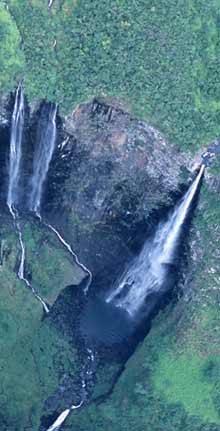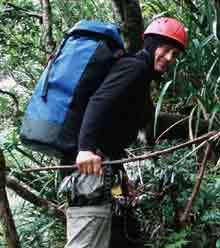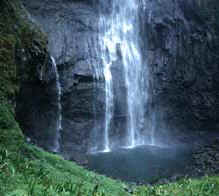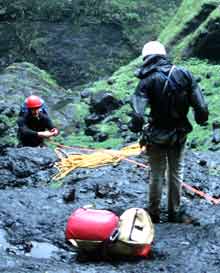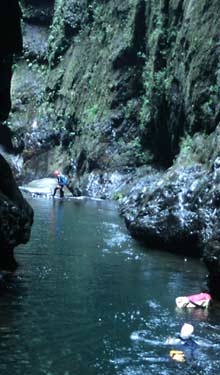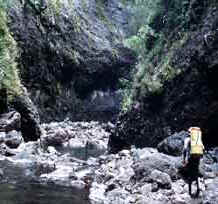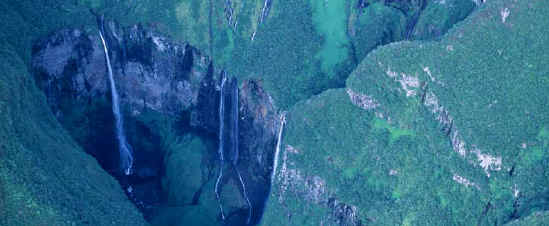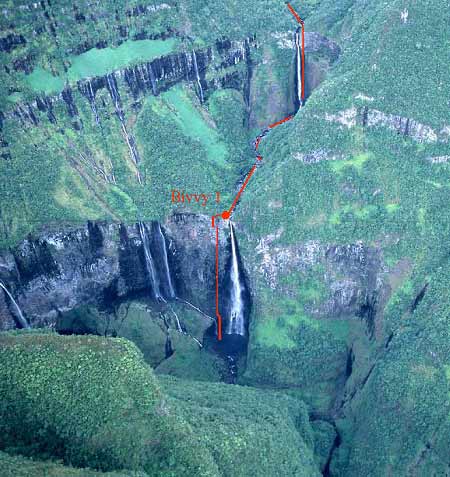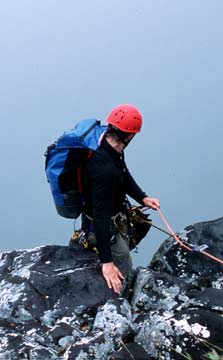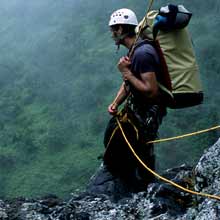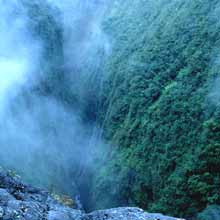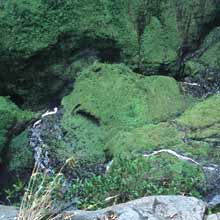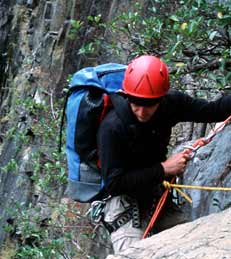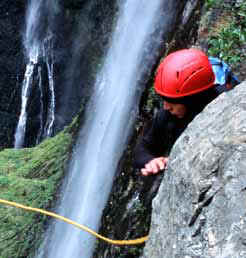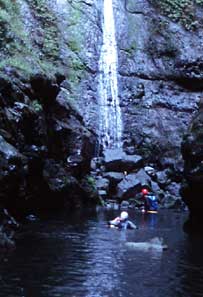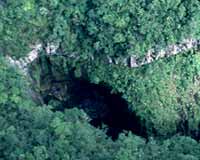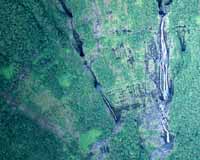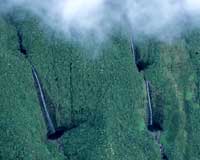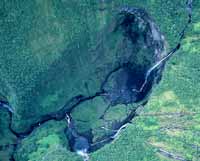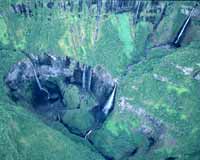|
CANYONEERING REUNION ISLAND
The TROU de FER
by John Hart
October 2002 (Modified
and Reloaded, October 2012)
(click on any image for a larger version and
more description)
INTRODUCTION
I had visited
Reunion Island
for a short time in June, and
was lucky enough to have had a cloud-free morning on the last day of my stay
when
I flew in an ultralite* over the Trou de Fer (The Iron Hole), one of the biggest and
most dramatic canyons on Reunion, perhaps anywhere. In a distance of about two miles the Bras de Caverne
river plunges over three huge cascades, and then winds its way down a perpetually
wet narrows to join the Riviere de Mat on its way out to the Indian Ocean.
The total drop, mostly in the three waterfalls, is almost 3000 feet. The
narrows, called The Corridor, is a swift-water slot canyon. It
is especially wild after some
rain when there is a lot of water pouring into the Iron Hole from
the many canyons that feed into it. The Trou de Fer is
a difficult canyon with huge unforgiving walls that require considerable technical
to descend. It also has an unpredictable nature that
makes it quite dangerous.**
I was fortunate to have gone down some spectacular jungle canyons in
June, particularly Takamaka, and until I saw the grand scope of the Trou de Fer from the
air I swore that I didn't need to do it. Too big, too hard, too scary, real rough on my cameras, and difficult
for photography (my passion). But after I flew over it
in the ultralite I was so overwhelmed by its beauty that, well, I just had get
down in there. So in October I hooked up with
two guys from Reunion Sensations, Gabriel and Nicolas, and off we went with two
100m ropes,
bivouac gear, emergency equipment, and high enthusiasm, for a three day adventure. None of us had
done this canyon before, but we talked to M'Ric (the owner of the Ric-a-Ric
guide shop in St. Gilles) who had been through it recently and who said the
anchors were in good shape. M'Ric's route description seemed pretty complete,
although a little intimidating: multiple on-the-wall relays, and consecutive single-strand free rappels
in the 300 foot range, etc. Pretty hairy, it seemed to me.
It is hard to describe this place and do it justice.
The Hole itself is a circular wall with waterfalls pouring over from various
feeder canyons. It's almost 1000 feet deep and about as
wide. But just to get down to the edge of The Hole you have to
descend two "preliminary" 600'ish foot waterfalls of the Bras de
Caverne river. These are
multi-pitch walls too, with impressive free-air wire-of-the-spider raps. Ironically, they had
shown the video "Spider Man" on my airplane
over from the States to Paris.....
The Route from the Second Cascade (upper right) to the bottom.
The above aerial view shows the route from the second waterfall down
to the bottom of the Iron Hole. All the water pouring in flows out the
narrow slot at the lower right. The first cascade is shown in the image at the
left. It was dry. The water coming over the
upper right pour-off, illustrated above, comes from springs and side canyons in the 500 meters between
the first and second drops. If any water is indeed flowing over the first
fall, a bail-out is highly recommended.
INTO THE MIST
We used the single-rope method for most of the drops. You
rappel on one strand and the last person down carries the second rope-bag with the
pull rope. Minimizes tangles, but you need a good brake. Our two ropes were
mismatched anyway. One was 120m of
Canyon Pro 8mm that I had carried over from the US, and the other was a 10mm dry-treated
semi-dynamic 100m long cord we borrowed from a friend in Cilaos. Not my
first choice to rap on, but I was outvoted.
Kinda bouncy going down. My two companions used huits (figure of eights), rigged for
substantial braking action. I tried the leg-loop biner extra brake on the first short (60m) non-free
rap and found it much too fast with the particular rope we had. I switched
over to using a B-52 on a short dog-bone up from the harness, and a Trango Pyramid on the
leg-loop biner as a secondary descender. On the big 90+m free-raps, I
could just about take both hands off and stop. This was very
comforting. It was slow, but not tiring, and hey, this is one place
where you
really do want to hang out and enjoy the view.
Unfortunately there really wasn't too much
to be seen the first day when we did the first two walls. The
inevitable (it seems) clouds had moved in, actually rising up from below.
The swirling fog made for grand mystique and ambience. Dropping off the
edge and disappearing into the mist was something else! We ended up
day one at a very
impressive bivouac just on the edge of the big wall overlooking the Hole (see map
above).
ON THE WALL
In the Trou de Fer the crux move occurs as you rap down the
big 1000 foot wall between the huge Bras de Caverne waterfall and the twin
falls at the middle of the above route sketch. The whole wall is seriously undercut so that 25 meters down from
the foliage you are out on a lip facing a 700 foot free-fall. With
only two measly 100m cords we had
to get back to the wall in order to continue down. This is accomplished,
in principle, by
letting out 50 meters of rope and sending your strongest team-member down 45
meters. Using a "hook" attached to a throw rope he or
she tries to snag the wall and pull over to it. While locked
off and swinging around as we watched from above, Nicolas tried and tried
again to toss his home-brew "hook", made the night before out of a
tree branch, around a piece of vegetation growing out of the rock-face
about 6 meters away. It would look like it had caught, but then when
he tried to pull himself in it would snap free. 10 minutes went by. 15
minutes. Gabriel and I hung off the nose above. I was feeling a
little helpless and
exposed. A helicopter swung by (it was 10am). The Trou de Fer is
the prime destination of heli-tourists who pay $150 for a 20 second swing down
into the Iron Hole. What they saw must have made it worth their money, me and Gabriel lashed to an outcrop on the face, and Nicolas
swinging around crazily, suspended in mid-air below. We waved as if to
say, hey, we're OK. 20 minutes.
But then I started to think. Bad thing to do (thinking).
What if the wooden "hook" breaks altogether? What if the rope
it's attached to comes loose and it falls out of sight? Why didn't we
bring a backup hook? We're stuck here on the wall (pulled the rope already
to lower Nicolas). Gabriel said he'd heard it has taken 2
hours, and longer, to make this move. Gabriel said there have been a lot of helicopter
rescues in this canyon. Gabriel said this is a real risky
canyon.** OK... I started to try and assist by rhythmically pushing the rope in and
out, to swing Nicolas closer to the wall. Absolutely futile, but something
to do. Nicolas was in great shape and a very good technician, but he was
also the heaviest of our threesome, so as he started to pull himself and his
big pack in towards the wall he put a lot of stress on the wooden barb at the
end of his hook, which would then bend and release. I kept moving around
in my harness to keep my legs from going numb. Nicolas kept throwing the
hook. He tried jugging up the rope a little ways for a different angle of
attack. He tried to time his throws with his pendulum swings. 25
minutes. Then, finally, success! The hook had wedged in just right
and we were over to the wall! Big smiles, cheers, and a major sigh of relief. Now all we faced were a couple of
large big 300 foot free-raps and we'd be down. Hey, these didn't look so
bad now.
DOWN THE CORRIDOR
The big walls are only one part of the Trou de Fer.
All the water that pours into the Hole exits down a narrow jungle-slot
called The Corridor. This 2km stretch of waterfalls,
narrows, swimmers, lakes, down-climbs, etc., was a blast - so different from
hanging out on the big water-walls. It reminded me of the Narrows in
Zion, except more technical and with deeper water, vegetation clinging
here and there, and water pouring in all over the place.
You have to swim under the full force of a waterfall of the Bras de
Caverne river at a spot appropriately called "The Washing Machine." This was more
like what I was used
to, as in rapping down through the waterfalls in the canyons of Colorado.
But we were all a bit grateful the rain of the day before had stopped, and that the waterfalls pouring into the Iron Hole looked a little less
powerful
as we started down The Corridor.
The Corridor curves around a bit. There are long swims in
"lakes", really just wider areas damned up to form basins. The
"Lake of the Eel" was pretty neat, snaking around with huge cliffs running up both
sides. This section seemed like out of some science fiction movie - on
another planet where huge eels, thriving in the wet sub-tropical climate lurk
below the surface waiting for the next canyoneer to swim by (that was Gabriel's
story anyway). And every once and a while another stream would cascade into the
gorge to add its water to the beauty of the canyon.
After
negotiating the Corridor it's a two hour climb on a steep jungle track up
over a col to the Salazie road for a pickup and, eventually, a shower!
After three days in this wet muddy 100%-humid environment we were pretty ripe.
Some girls walked by us on the road as we were sitting waiting for our
ride. Oink Oink. They were not impressed.
THE JOY OF THE CANYON
We took our time doing this canyon. The first bivvy was at the edge of the Hole and
was pretty neat. The second was under a rock at the bottom of the Hole
and was awful, but memorable (in a way). The rock was sweating water, with only a few inches
clearance above your face, and sleep just didn't
happen. In total we
spent about 17 hours actually canyoneering and hiking out. With the 14 hours of light
in November it is probably possible to race through here in one day.
And this has indeed been done. But it was nice to be able to make extra
stops for
photography, and to enjoy the ambience and mystique of the place as the clouds swirled in
and out, with waterfall spray occasionally intersecting the intermittent sunlight
in a glorious
display of rainbows. Indeed this is what canyoneering is about for
me. It's not how fast you can go. It's really about using your
technical training to get into a remote and inaccessible
canyon while taking due care to be in harmony with it, and spending
sufficient time to experience the moods of a spectacular wilderness like the
Trou de Fer.
More Aerial Views of the Iron Hole and Some of Reunion's
Other Great Canyons.
* All aerial views in this report were taken by
the author while flying low and slow and leaning out from the passenger seat of an ultralite aircraft chartered from Felix ULM in Le Port.
**A SAD NOTE: The Trou de Fer is known to be a very dangerous
canyon. With 20 feet of rain per year the porous rock is incredibly
loose and slippery. Rockfalls are a real and persistent danger and
the big walls leave no room for even the smallest inadvertent error. Sadly, a substantial number of people have lost their lives
in
here in the last decade. Tragically, a week after we went through it
claimed the life of yet another, in a freak accident. A good friend
of another canyon enthusiast I had met in Arizona, Luc was a teacher
and a highly skilled part-time canyon guide. He was a man who truly
loved canyons and who worked passionately to introduce people to these majestic
places, showing them how to access the beauty to be found within. This
photo-essay is offered in this spirit of sharing these wonders.
|

